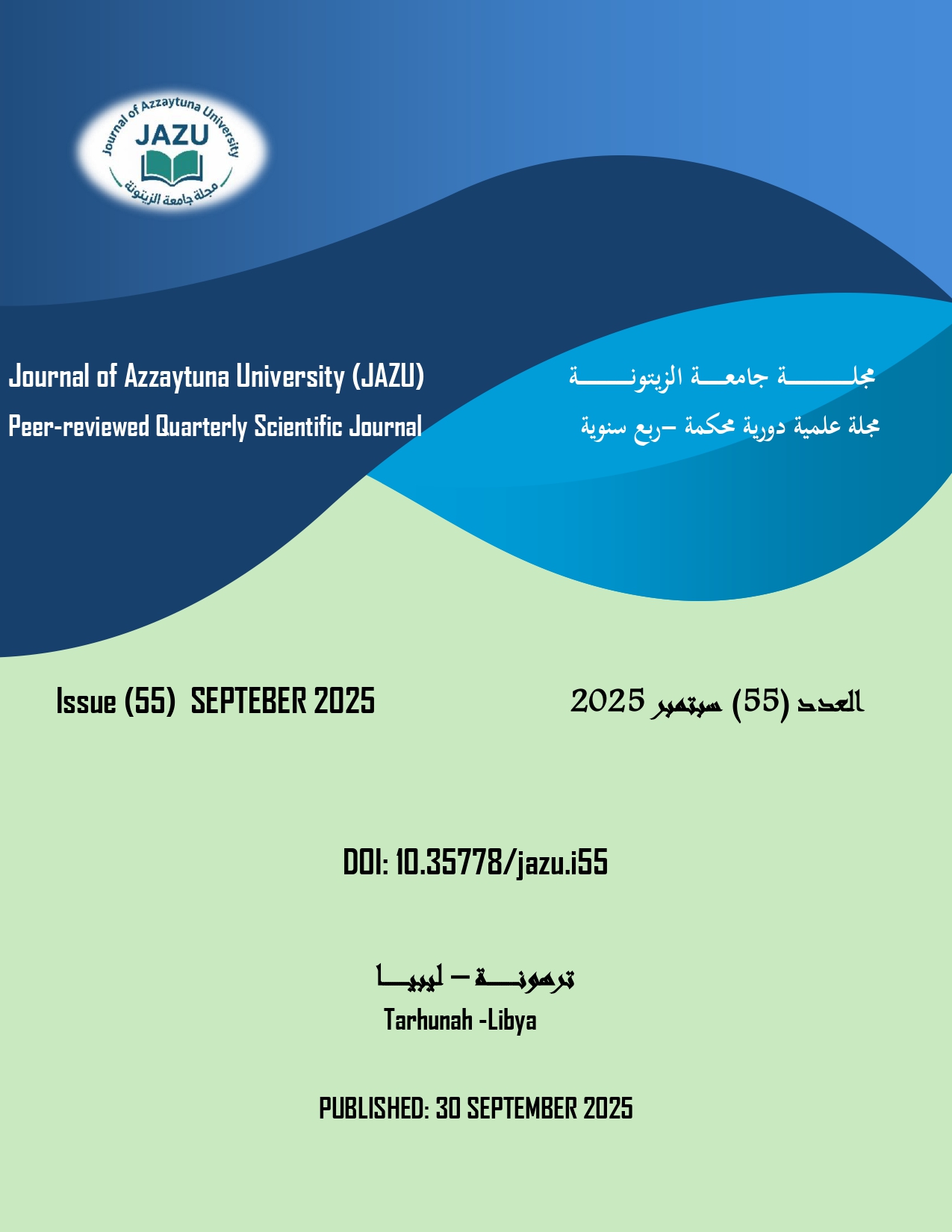The Relationship Between Urbanization and the Spread of COVID-19 in Libya: A Study in Medical Geography
DOI:
https://doi.org/10.35778/jazu.i55.a572Keywords:
COVID-19, Libyan Regions, Medical Geography, Spatial Distribution, Urban Centers, UrbanizationAbstract
This study aimed to trace the temporal evolution of COVID-19 infection rates, identify peak and decline phases during the pandemic’s spread, and examine their spatial variation and relationship with lifestyle patterns. It analyzed differences in infection rates across regions, using medical geography as a general methodological approach. This framework focuses on the geographical distribution of diseases and their relationship with both natural and human geographic factors particularly urban characteristics such as the size and number of urban populations and cities within each region. To achieve the study’s objectives, a descriptive-analytical method was employed to present the trends and temporal variations of the phenomenon, while an applied statistical method was used to test the hypotheses, drawing on the Statistical Package for the Social Sciences (SPSS). The study found a marked cumulative rise in COVID-19 infections from the end of 2020 to the end of 2022, with a relatively stable period from January to August 2021. Statistical analysis revealed a strong positive correlation between the number and size of urban populations and centers, on the one hand, and regional infection rates, on the other. This supports the hypothesis and provides a foundation for future spatial and urban-based analyses.
Downloads
References
Arabiya ، مارس، 25)، كورونا يواصل تفشيه عالمياً رغم القيود المشددة، العربية، 10، يوليو، 2025، من: https://www.alarabiya.net/coronavirus/2020/03/25/
أخبار الأمم المتحدة. (2020، 11 مارس). منظمة الصحة العالمية/ يوم 2 أغسطس 2025، من:
https://news.un.org/ar/story/2020/03/1051041
بلوم، أسمهان.، وآخرون. (2018). التأصيل النظري لتفسير العلاقة بين الإنسان والبيئة: دراسة سوسيولوجية. المجلة الدولية للبيئة والمياه، المجلد 7، العدد 1، ص. 4.
الحداد، عوض يوسف. (2004). ليبيا: دراسات في الحيز الجغرافي. بنغازي: جامعة قار يونس، قسم الجغرافيا.
الحسن، عبدالرحمن محمد. (2013). الجغرافيا الطبية. الدويم: شركة مطابع السودان للعملة.
زناتي، ج. (2015). النمو الحضري وانعكاساته على المحيط العمراني. عمان: الدار المنهجية للنشر والتوزيع.
سراج، محمد إبراهيم.، و حليوة، جمال جمعة. (2021). جائحة فيروس كورونا المستجد (كوفيد-19) والعمران. مجلة الهندسة – جامعة الأزهر، المجلد ، العدد60.
عطال، مسعودة. (2009). النمو الحضري وعلاقته بمشكلة البيئة الحضرية: دراسة ميدانية بحي طريق حملة بمدينة باتنة (رسالة ماجستير غير منشورة). قسم علم الاجتماع والديموغرافيا، كلية العلوم الاجتماعية والإسلامية، جامعة الحاج لخضر، باتنة، الجزائر.
فتح الله، عادل إدريس. (2020). النظام الحضري في ليبيا: دراسة في جغرافية المدن. في مجلد. لامة وآخرون (تحرير)، بحوث مختارة في الجغرافيا. بنغازي: دار البيان للنشر والتوزيع.
المركز الوطني لمكافحة الأمراض. (2020–2022). مجموعة تقارير دورية حول الوضع الوبائي في ليبيا خلال جائحة كوفيد-19. طرابلس: المركز الوطني لمكافحة الأمراض. https://ncdc.gov.ly
مصلحة الإحصاء والتعداد. (1973). النتائج والنهائية للتعداد العام للسكان لسنة 1973. طرابلس: مصلحة الإحصاء والتعداد.
مصلحة الإحصاء والتعداد. (1984). النتائج والنهائية للتعداد العام للسكان لسنة 1984. طرابلس: مصلحة الإحصاء والتعداد.
مصلحة الإحصاء والتعداد. (1995). النتائج الأولية للتعداد العام للسكان لسنة 1995. طرابلس: مصلحة الإحصاء والتعداد.
الهيئة العامة للمعلومات. (1973). النتائج الأولية والنهائية للتعدادات السكانية لسنة 1973. طرابلس: الهيئة العامة للمعلومات.
الهيئة العامة للمعلومات. (2006). النتائج النهائية للتعداد العام للسكان لسنة 2006. طرابلس: الهيئة العامة للمعلومات.
Abo Al-Sheikh, S. S., & Alsousi, A. S. (2022). COVID-19 vaccines and epidemic trends of COVID-19 in Palestine. Israa University Journal of Applied Science, Vol 6, No1.
Ahmed, S. H. et al., (2020). Introduction to COVID-19, history, impact, symptoms and prevention. Pakistan Journal of Medical & Health Sciences, Vol14, No 2.
Avetisyan, S. (2020, May 16). Coronavirus and urbanization: Do pandemics are anti-urban? (Working paper). Central Bank of Armenia, Economic Research Department.
Baruah, H. K. (2020). A simple method of finding an approximate pattern of the COVID-19 spread. Department of Mathematics, The Assam Royal Global.
Bhadra, A., Mukherjee, A., & Sarkar, K. (2021). Impact of population density on Covid-19 infected and mortality rate in India. Modeling Earth Systems and Environment, Vol 7.
Celestini, A., Colaiori, F., Guarino, S., Mastrostefano, E., & Zastrow, L. R. (2022). Epidemic risk assessment from geographic population density. Applied Network Science, Vol 7, No 39.
Clemow, F. G. (1903). The geography of disease. Cambridge Geographical Series. London: Cambridge University Press.
Hussain, M., & Imitiyaz, I. (2018). Urbanization concepts, dimensions and factors. International Journal of Recent Scientific Research, Vol. 9, Issue, 1.
Mackenzie, J. S., & Smith, D. W. (2020). COVID-19: A novel zoonotic disease caused by a coronavirus from China: What we know and what we don’t. Microbiology Australia, Vol 41, No 1.
Ondrejková, A., et al., . (2022). Retrospective overview of COVID-19 in Europe. Folia Veterinaria, Vol 66, No 2.
Peng, X., Chen, X., & Cheng, Y. (n.d.). Urbanization and its consequences. In Y. Zeng (Ed.), Demography (Vol. 2). Encyclopedia of Life Support Systems (EOLSS).
Teppone, M. (2022). The phase dynamics of the COVID-19 pandemic: A systematic analysis of 213 countries and territories. Problemy Sotsial'noi Guiney, Zdravookhraneniia i Istorii Meditsiny, Vol 30. No 3.
United Nations, Department of Economic and Social Affairs, Population Division. (2019). World population prospects 2019: Highlights.
Vine, M. M., Mulligan, K., Harris, R., & Dean, J. L. (2014). The impact of health geography on public health research, policy, and practice in Canada. International Journal of Environmental Research and Public Health, Vol 11, No 6.





